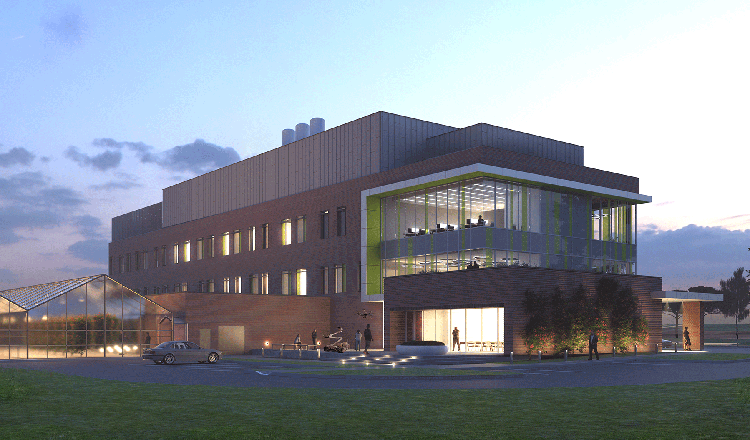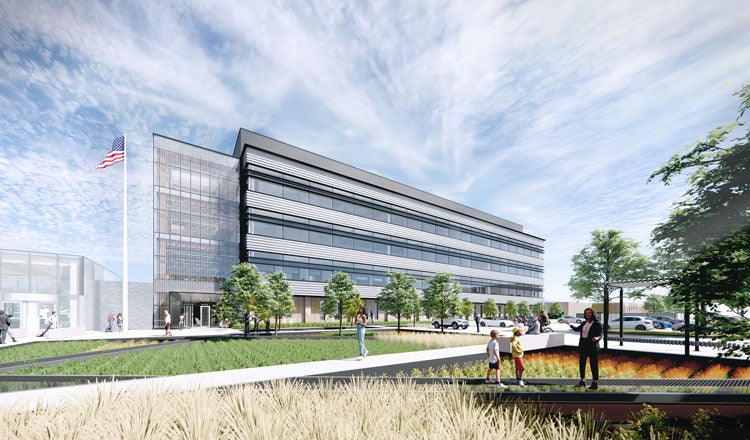
Feeding the Future: How Design is Supporting USDA’s Mission
In 2022, more than 12.8% of households in the United States were food insecure — meaning they lack consistent access to enough food to meet the nutritional needs for an active, healthy life for all household members. Climate change, inadequate infrastructure and poverty, alongside other factors, contributed to a larger global trend of decreasing food affordability and a widening gap between the most and least food-secure countries. To combat this issue, agricultural researchers across the country are looking for ways to create a more abundant, resilient, and environmentally friendly food supply. Designing environments that facilitate innovative research is essential to ensure the researchers can accomplish this mission.
As part of the United States Department of Agriculture's Innovation Program agenda, our most recent work supports government efforts to increase American agriculture production by 40 percent while cutting its environmental footprint in half by 2050. Our work strengthens, supports and contributes to the American economy through design that supports environmentally sound, economically viable and consumer-focused products.

Sowing Seeds Across the U.S.
For decades, we have been working with clients such as the USDA to develop state-of-the art agricultural research facilities. For example, at the USDA Dairy Forage Research Center at Prairie du Sac, Wisconsin, located about 30 miles away from the University of Wisconsin-Madison campus, researchers will work with UW-Madison agricultural scientists to better understand how dairy forage — or feed — contributes to cows’ output and emissions, so that forage plants and dairy cattle diets can be modified to improve digestibility and nutrient utilization for a greater economic sustainability for dairy producers. Cattle are one of the top sources of agricultural greenhouse gas emissions worldwide, so lowering these emissions while improving their dairy output makes them a more sustainable food source. The facility features state-of-the-art animal Emissions Chambers, which allow researchers to gather detailed data on how various kinds of forage impact the cows’ output. This highly specialized research center is a working farm and a research facility, producing milk while research is done.
The Sam Farr United States Crop Improvement and Protection Research Center in Salinas, California, is another USDA collaboration advancing the field with researchers from USDA Agriculture Research Services, USDA’s Animal and Plant Health Inspection Service, and the University of California, Davis. Housing research on fruit and vegetable production, includes three independent greenhouses allowing for research on distinct species without the risk of cross-contamination. It will focus on research dedicated to sustainable agriculture and organic farming practices which protect the sensitive marine ecosystems of the nearby Monterey Bay. The center will be essential in developing innovative technologies and approaches, attracting researchers from around the world.
At the University of Nebraska-Lincoln, we designed two buildings for the new National Center for Resilient and Regenerative Precision Agriculture which will play a vital role in researching improving water and climate resiliency, precision crop and animal production, and digital agriculture. Plans for the campus include tens of thousands of gross square feet in new greenhouse, lab, and office space which will serve 150 USDA-ARS scientists — double the amount currently in Lincoln. The additional space will also allow for greater collaboration with other UNL entities such as the School of Engineering and School of Computing.

Energizing Through Design
As designers, our job is to create the best possible environment for researchers to work in. Our facilities must meet the technical demands of the research they carry out, but also create an environment which energizes researchers in their day-to-day lives.
Increasing access to natural light benefits mental health and clarity for everyone no matter the space. Lab spaces are often isolated from natural light to ensure a stable environment. Many existing lab building interiors, for example, are designed as a system of closed corridors, blocking access to light. But modern approaches to design recognize the benefits natural light have on users and find ways to integrate it. We have designed facility concepts that use mass timber construction to create an open, warm environment and allow sunlight to penetrate throughout the building. The lab spaces are situated on the building’s perimeter, bringing access to sunlight as well as views inward for people to observe the work being done.
Designers also support researchers through space utilization. Today, the most successful research facilities are designed to provide a holistic experience for all users. One example is the increased emphasis on including dedicated collaboration spaces. These spaces not only boost researcher mental health by providing opportunities for socializing, but they also aid the research mission of the lab by creating opportunities for the cross-pollination of ideas between researchers who otherwise may not interact. The National Grape Improvement Center in Geneva, New York, embodies this concept with its phone booths, conference rooms, and collaboration zones which accommodate quiet work and interdisciplinary discussions.
Beyond promoting mental health and collaboration, we strive to create spaces that meet modern research needs. The need for more workshop and engineering spaces in agriculture research facilities is a trend on the rise in recent years. Tools like drones and rovers are becoming more common in the field to monitor crops and collect data more efficiently. Because of this, modern labs need spaces to service and modify these machines. The increasing sophistication of the data that can be collected also necessitates spaces to be able to store and process said data. In the University of Nebraska-Lincoln’s Wheat, Sorghum, and Forage Research facility, researchers use these tools to gather samples, which requires a wet lab environment to analyze the organic material as well as a dry lab environment to service the tools and crunch the data. The National Grape Improvement Center also implements a range of lab layouts, including hybrid office and lab spaces, to facilitate computational data analysis and robotics.
Although we strive to meet the needs of today and tomorrow, science is an inherently innovative discipline. Methods and needs can change drastically over time, in a way that is impossible to predict. Our approach to site analysis, lab design, and planning ensures that these spaces are flexible, efficient, and economical.
In addition to Gabriela Kleiman, additional contributors include Diane Hamlin, Warren Hendrickson, Morten Thomsen, Susana Erpestad and Tyler Dye




